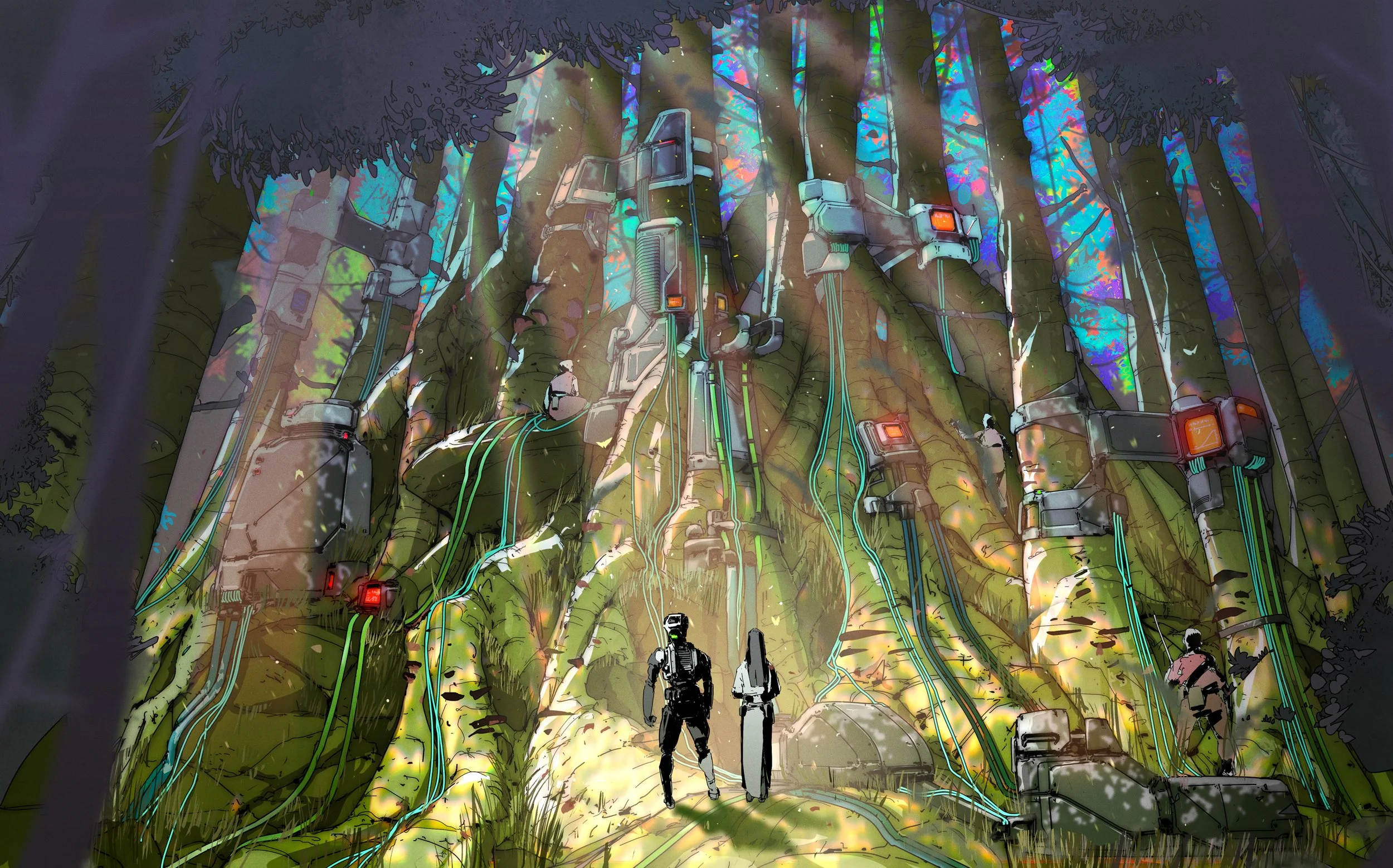
01: A Helping Hand
Botany & Horticulture
Log: 07 March 2142
Today marks 24 days since we integrated rudimentary hydrosiphoning and pH alignment machinery into seedling HF0091. Germination occurred on day 28, and integration on day 59 (by way of sap soldering). The seedling is 71 days old. It is now beginning to show signs of decline, including premature wilting of new growth, yellowing lower leaves, and deterioration at the installation nodes (which might not be a problem itself if the plant can spend time to recover, but does create vulnerabilities when it comes to infestation and infection).
Despite its decline, this is by far the longest we’ve managed to sustain a specimen after integration. The previous record was 7 days with seedling DC0033. This is actually meaningful progress and it could lead us to identifying which species will click with our installs. Hampton and Syse are still on the fence of course, they’re such data driven people sometimes and, to be fair, they’re skepticism is justified considering we’ve only attempted integration on 37 out of over 200 species found in the forest, but we are just two years in. Not that all of these need intervention, but data is data nonetheless. I suppose it could just be their impatience beginning to bear, or maybe they just see the mood swings of climate change nipping at our heels. Meaningful progress will come, I’m sure of it. We have a long way to go before we’re ready for ground trials, but hopefully I can keep them engaged until then. They’ve been here since ‘30 after all; it’s been a long time.
Last week Syse, Ygress and I were talking with a few of the engineers who had worked on the original Hydrostasis systems about possibly developing a data scraper model that could give feedback for optimizing care and integration and help us forecast growth rhythms. They actually responded pretty enthusiastically to that idea. I can see the systems upkeep post phase 1 integration is taking a toll on them, so giving them some purpose will be revitalizing, I hope...
A couple years ago they, along with the field maintenance team, filed a joint request over “security concerns” and actually got some people in D&F to build them a bunch of these mechanical staves that act as keys to the systems on the trees. They run around calling them the Arbor Scepters--no doubt influenced by Kimura’s high fantasy obsession-- but most of us just call them “tree keys”. The maintenance team inserts them into the terminals and is able to take readings and adjust things like water flow, pressure, absorption, pH, etc. Without a key, the systems are locked down and inaccessible. I still vow they just wanted some cool new toys to play with, even if they do technically serve a purpose. Ygress has a dream of using one, but maintenance is incredibly stingy and protective of them. Kimura keeps them locked away in a room that only his team and specific cleared individuals have access to. I suppose I should be grateful though, if Ygress were to wield the power of the key, he might leave me all alone in the lab without anyone who can relate with my love of flower pressing.
At this point the atmosphere around the Rebourne crew does feel like it needs a bit of a revitalization, and this new AI model might be what we need to continue pushing through the early stages of seedling growth. I should ask Purnawati to come up with a pitch for OPEAS in the next few weeks--she has always had a knack for glittering up the mundane. As we attempt integration on new species and carry out maintenance and upgrades on promising specimens, we will definitely need all the help we can get.
Dr. Vivian Pham, Director of Botany & Horticulture
Operations & Oversight
Log: 03 February 2144
Today Dr. Kahnwald informed me that her team has pushed the 1.3 build of LEAF to the server and they should have all the pots updated by the end of the week. I’ve been told they worked out the kinks with inconsistent sensor readings between species which was the last larger hurdle they were trying to solve. This should allow us to have a bit more speed and luck with integrations.
From here on out the updates to LEAF should be piecemeal unless they hit an unexpected bump in the road. She’s still concerned that it might suffer data bias from the initial training sets when we start ground trials, but progress has been consistent enough that there shouldn’t be much resistance squeezing another round of funding out of Cognitura.
In the 2 years since we started using the alpha build of LEAF, Botany has slowly been able to improve some seedlings’ lifespans to around 3 months give or take. It’s pretty magical progress to witness--our team defying the laws of biology. Last week Bok was updating me on their “Species-Metal Affinity Atlas”. Frankly, most of the time my brain can’t compute the science jargon, but I’m thankful they make the effort to be thorough with their recordkeeping, otherwise OPEAS and EcoMetal might not be as generous with their piggy banks.
Many of us have been here since the beginning and I don’t think I was the only one starting to get fidgety with the slow crawl of progress at the end of ‘42. At least I hope I wasn’t the only one. God knows Hampton has heard enough of my whining to last a lifetime. I expect once we dive into ground trials and start getting our hands dirty with proper field research, the world will begin to see the real benefits of what we’re trying to accomplish here.
Willard Syse, RPI Director
Roots Down, Spirits Up!
Verdant Circuit Newsletter, 17 August 2146
Just this week, the tireless folks over at the Rebourne Preservation Initiative celebrated a huge milestone: the very first seedling has been planted right into the forest soil! That’s right, after six years of grit, patience, and high-tech green-thumb magic since Project Ironbranch kicked off, we’re finally seeing the roots take hold.
Solenne, our longtime contact at RPI, tells us the team is both proud and deeply grateful to have reached this point. For them, this step signals not an ending, but a beginning. It’s the start of the careful, long-term endeavor of building a healthy, resilient future for our forest. “This is the start of the real work,” she said—and around here, we know that means it’s time to roll up sleeves and keep moving forward.
So what’s next then? The plan is to continue planting seedlings of various species throughout the forest, while studying growth patterns, soil composition, and other ecological indicators. A retrofitting phase is also underway to upgrade existing elder trees with improved monitoring technology developed since the end of Operation Hydrostasis. That means better data collection and health monitoring, smarter care, and a stronger, more sustainable forest for everyone.
The RPI team wants to send a heartfelt thanks to everyone in Rebourne—whether by lending tools, offering encouragement, or simply staying curious about the forest’s future, your support has made the difference. They’ve also asked us to give a shoutout to a few of our local businesses:
The Hollow, for those life-saving coffee runs that keep the Integration team sharp during fragile installs.
Huynh Family Nursery, for lending extra training pots when too many of the omnipots were undergoing maintenance—Botany & Horticulture sends their love!
Ijo’s, whose impeccable ramen keeps the Soil & Mycology team fueled and focused on their late nights (and always with extra mushrooms).
RDWP, for always being a steady hand when it comes to keeping the forest utility lines running like clockwork. Field Ops & Maintenance couldn’t do it without you.
Finally, we end with a wonderful message from RPI Director Syse:
"To every resident of Rebourne I wholeheartedly want to give my thanks. Despite being here for more than 15 years, having seen faces come and gone, one thing remains true: the generosity, comradery and optimism of this place is unwavering. My family and I wouldn’t still be here if it weren’t. The progress we’ve made together reflects the strength of this community. Your support has been vital, and none of this would be possible without it. Here at RPI we feel like kids again. Buzzing with excitement, ready to take the next steps and see what the future holds. Soon we hope to show the world the incredible work we are doing, and I hope you will all continue to be a part of that moment, here, in this incredible place. Personally, there is no other place I’d rather be.”
As always, we’ll be here to keep you updated on the steps ahead—big and small—as our forest and our town continue to grow together. Whether it’s new tech, fresh sprouts, or shared moments around town, the story of Rebourne is one we’re all writing together.
Claire Desmond, Senior Writer for the Verdant Circuit
